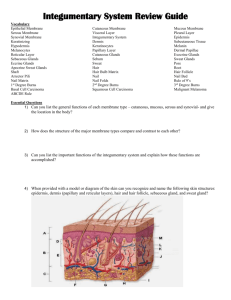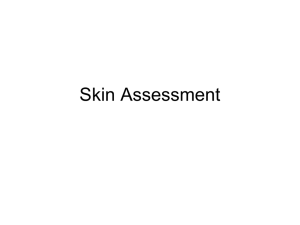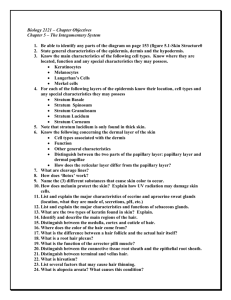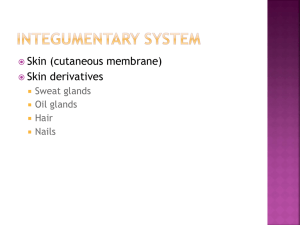Chapter 6 outline
advertisement
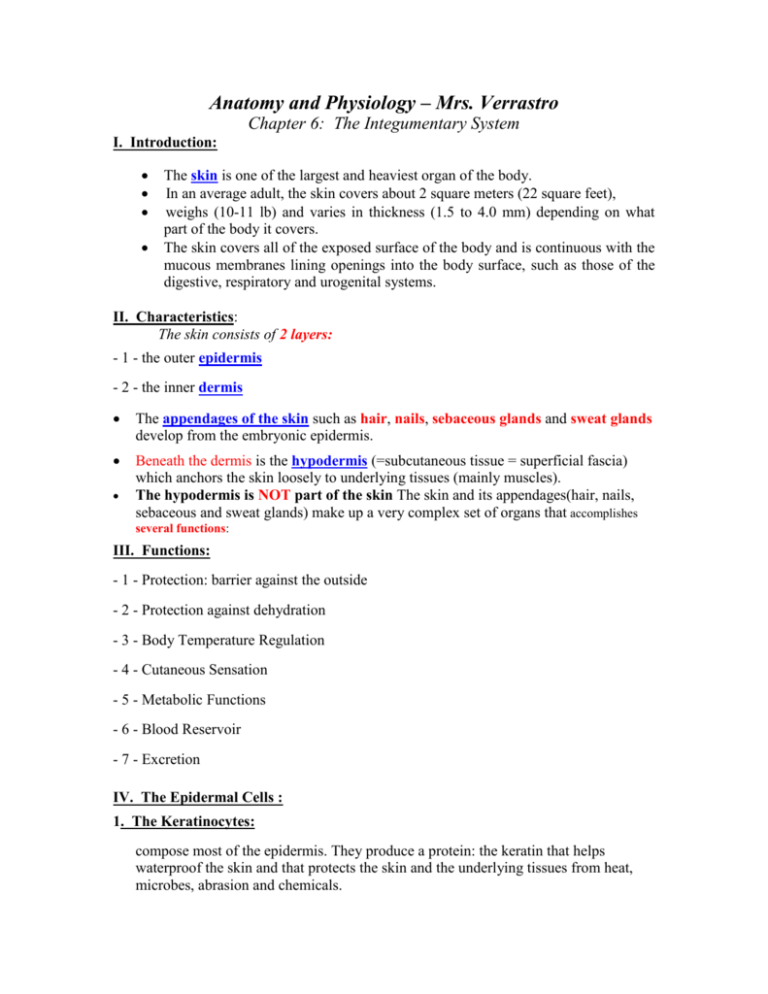
Anatomy and Physiology – Mrs. Verrastro Chapter 6: The Integumentary System I. Introduction: The skin is one of the largest and heaviest organ of the body. In an average adult, the skin covers about 2 square meters (22 square feet), weighs (10-11 lb) and varies in thickness (1.5 to 4.0 mm) depending on what part of the body it covers. The skin covers all of the exposed surface of the body and is continuous with the mucous membranes lining openings into the body surface, such as those of the digestive, respiratory and urogenital systems. II. Characteristics: The skin consists of 2 layers: - 1 - the outer epidermis - 2 - the inner dermis The appendages of the skin such as hair, nails, sebaceous glands and sweat glands develop from the embryonic epidermis. Beneath the dermis is the hypodermis (=subcutaneous tissue = superficial fascia) which anchors the skin loosely to underlying tissues (mainly muscles). The hypodermis is NOT part of the skin The skin and its appendages(hair, nails, sebaceous and sweat glands) make up a very complex set of organs that accomplishes several functions: III. Functions: - 1 - Protection: barrier against the outside - 2 - Protection against dehydration - 3 - Body Temperature Regulation - 4 - Cutaneous Sensation - 5 - Metabolic Functions - 6 - Blood Reservoir - 7 - Excretion IV. The Epidermal Cells : 1. The Keratinocytes: compose most of the epidermis. They produce a protein: the keratin that helps waterproof the skin and that protects the skin and the underlying tissues from heat, microbes, abrasion and chemicals. - 2 – The Merkel Cells sensory receptors (touch). They associate with a disclike sensory nerve ending to form the Merkel disc. - 3 – The Melanocytes synthesize the melanin pigments which protect the skin against ultraviolet damage. - 4 – The Langerhan Cells macrophages used in the defense against microorganisms. V. The Epidermal Layers ( From the deepest to the most superficial ) 1 - the stratum basale (or stratum germinativum): is the deepest epidermal layer. It consists of one row of cuboidal to columnar shaped cells. Those cells are mostly stem cells that divide rapidly to produce new keratinocytes which push up toward the surface and become part of the more superficial layers (You can understand why this layer is called "germinativum": it "germinates" cells). Ten to 25% of cells found here are melanocytes: their long branching processes extend in between epidermal cells and reach into the more superficial Stratum spinosum. Melanocytes that synthesize the pigment melanin. Melanin passes on from the melanocytes into the keratinocytes and will protect them from the destructive effect of ultraviolet radiation. Merkel cells are also found in this layer. - 2 - the stratum spinosum: is 8-10 layers thick. The keratinocytes contain thick bundles of intermediate filaments (tonofilaments) made of a tension-resisting protein. Histological preparations shrink these cells and make them look prickly hence the name of this layer: spinosum (little spine). Scattered amongst keratinocytes are the Langerhans'cells that are most abundant in this layer. are immediately adjacent to the dermis and thus, contain the only epidermal cells that receive adequate nourishment (by diffusion of nutrients from the dermis). As the daughter cells are pushed upward, away from the source of nutrition, they gradually die and their soft protoplasm becomes keratinized (hard). - 3 - the stratum granulosum: here the keratinization process begins and the cells begin to die. This layer is called granulosum because the cells contain granules of the precursor of keratine. - 4 - the stratum lucidum is only found in thickened areas of the epidermis such as the sole of the feet. The cells appear clear (hence lucidum in their name: luci means clear) because of an accumulation of keratin precursor. The cells begin to degenerate. - 5 - the stratum corneum: is the outermost layer composed of dead, flat, keratinized cells which are being sloughed off (they are your dandruff and the flakes that slouch off dry skin. Corneum means horn: hard dead cells. VI. THE DERMIS The average thickness of the dermis is about 1 to 2 mm and varies from 0.6 mm on the eyelids to 3 mm or more on the soles and palms. It contains lots of nerve fibers, sensory receptors, blood and lymphatic vessels as well as the hair follicles, and the sebaceous and sweat glands. The dermis consists of two layers: - 1 - the Papillary layer is the outer layer closest to the epidermis. It is composed of areolar loose connective tissue proper. Its superior region contains fingerlike projections called dermal papillae (also give the layer its name: papillary) that indent the epidermis. Dermal papillae contain capillaries, bare nerve endings (pain receptors), Meisner corpuscles (touch receptors: make us feel light touching) and the disclike sensory nerve endings of the Merkel disks. - 2 - the Reticular layer is the deeper layer and the thickest (4/5th of the dermis). It is made of dense irregular connective tissue proper containing thick bundles of interlacing collagen fibers and some coarse elastic fibers that run in several directions (but mostly in directions that are parallel to the skin surface). The collagen fibers in the reticular region provides the skin with strength and extensibility (= ability to stretch) and elastic fibers provide its elasticity (= ability to return to the original shape after stretching). The reticular layer is richly supplied with blood vessels and nerves, and contains sensory endings for touch (Pacinian corpuscle for sensing deep pressure such as bumps), pain, heat, cold, etc. The epidermis projects down into the dermis to form sweat glands, sebaceous glands and hair follicles. VII. HAIR The primary function of hairs is protection: in human, hairs protect the scalp from injury, from the sun ray and decrease heat loss. Eyebrows and eyelashes protect the eye from foreign particles. Hairs in the nostrils filter the air we inhale and hairs in the external ear canal also prevent foreign particles to penetrate there. Hairs are made of dead keratinised cells. The two regions of a hair are: - 1 - the shaft It is the portion of the hair that projects from the surface of the skin. The shape of the shaft determines the curliness of your hair: round shaft -> straight hair oval shaft -> wavy hair flat shaft -> kinky hair - 2 - the root - It is the portion of the hair embedded in the skin. It extends from the epidermal surface into the dermis but in the scalp, it can extend into the hypodermis. The hair (shaft and root) is made of three tubes that fit into each other. The three tubes are made of keratinised cells. The outer tube is the cuticle: it is made of one layer of heavily keratinised cell. The middle tube is the cortex: It contains several layers of cells. The cells contain pigments in dark hair and air bubbles in white hair. The inner tube is the medulla: it is composed of 2 or 3 rows of cells containing pigments and air spaces. VIII. SEBACEOUS GLANDS Sebaceous glands or oil glands are simple branched areolar glands. Functionaly they are holocrine glands. They secrete the sebum (seb = oil) an oily product. Sebum is usually secreted into a hair follicle but in a few regions of the body (lips and mammary papilla for exemple) they are directly secreted onto the skin surface. Sebum is a natural skin cream: it helps hair from becoming brittle, prevents excessive evaporation of water from the skin, keeps the skin soft and contains a bactericidal agent that inhibits the growth of certain bacteria. Sebaceous glands are scattered all over the surface of the skin except in the palms, soles and the side of the feet. IX. SWEAT GLANDS: Sweat glands or sudoriferous glands are simple coiled tubular glands. They are divided into two principal types: eccrine and apocrine. Eccrine glands are the most common. Their secretory portion can be located in the dermis or in the hypodermis. They produce sweat, a watery mixture of salts, antibodies and metabolic wastes. Sweat prevents overheating of the body and thus helps regulate body temperature. Apocrine glands are found mainly in the skin of the armpits, of the anogenital areas and of the areola of the breasts. Their secretory portion can be located in the dermis or in the hypodermis. Their excretory ducts open into hair follicles. Their secretion is more viscous than that of the eccrine glands. They start secreting at puberty and may be analogous to the sexual scent glands of other animals. Ceruminous glands (or ear wax glands) and mammary glands are modified apocrine sweat glands. X. NAILS Nails are hard plates of tightly packed keratinized cells. They are clear and cover the dorsal surface of the last phalanges of fingers and toes. Nails protect the the ends of the fingers, allow us to scratch various parts of our body and help us grasping and manipulating small objects. Each nail is made of three regions: 1- the nail body: portion of the nail that is visible. The nail body rests onto the nail bed: an epithelium made only of the stratum basale and the stratum spinosum. There are no stratum granulosum, stratum lucidum and stratum corneum in the nail bed. 2- the free edge: visible portion of the nail that extend past the end of the digit. It is the distal part of the nail that you clip every now and then. 3- the nail root: hidden portion of the nail that is embedded in a fold of skin (or nail fold). The cuticle is the stratum corneum of the nail fold that is pushed forward over the nail. XI. The Hypodermis The Hypodermis is NOT part of the skin It consists mainly of adipose tissue plus some areolar tissue. "Beer belly" in man and thick thighs and buttocks in female are due to too much fat stored in the hypodermis of these regions of the body. Hypodermis shares the skin protective functions: it stores fat and thus helps prevent heat loss and acts as a shock absorber; it anchors the skin to the underlying structures allowing the skin to slide almost freely over them. This feature ensure that blows just glance of the body without injuring the tissues below





